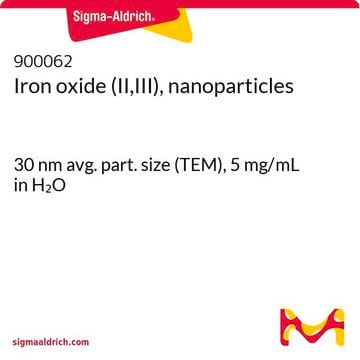The majority (>95%) of the gold nanoparticles are spherical.
742090
Gold nanoparticles
400 nm diameter, stabilized suspension in citrate buffer
Synonyme(s) :
Au NP, Gold Colloid
Sélectionner une taille de conditionnement
Sélectionner une taille de conditionnement
About This Item
Produits recommandés
Niveau de qualité
Forme
nanoparticles
suspension
Contient
Proprietary Surfactant as stabilizer
Concentration
~1.9E+8 particles/mL
Diamètre
400 nm
PDI
<0.2
Température de stockage
2-8°C
Chaîne SMILES
[Au]
InChI
1S/Au
Clé InChI
PCHJSUWPFVWCPO-UHFFFAOYSA-N
Vous recherchez des produits similaires ? Visite Guide de comparaison des produits
Application
This material is highly monodisperse (<12% variability in size and shape), and provides significantly improved surface reactivity. Applications include Surface Enhanced Raman Lables, Sensing/Detection, Biological Targeting, Plasmonics and Electronics.
Informations légales
Code de la classe de stockage
12 - Non Combustible Liquids
Classe de danger pour l'eau (WGK)
nwg
Point d'éclair (°F)
Not applicable
Point d'éclair (°C)
Not applicable
Faites votre choix parmi les versions les plus récentes :
Déjà en possession de ce produit ?
Retrouvez la documentation relative aux produits que vous avez récemment achetés dans la Bibliothèque de documents.
Les clients ont également consulté
Articles
Gold (Au) nanoparticles have tunable optical and electronic properties and are used in a number of applications including photovoltaics, sensors, drug delivery & catalysis.
Silver nanomaterials have unique physical, chemical, and optical properties that are currently being leveraged for a wide variety of biological applications.
Recent research highlights tunable properties of inorganic nanoparticles, driving interest in optoelectronics.
-
What is the shape of the gold nanoparticles?
1 réponse-
Utile ?
-
-
How do you attach gold nanoparticles to peptides and peptide conjugates?
1 réponse-
To view information on how to attach gold nanoparticles to peptides and peptide conjugates, please view the information in the reference - Rosenthal, S. J. and Wright, D. W. (Eds.). (2005), p. 91-92. NanoBiotechnology Protocols. New Jersey. Humana Press.
Utile ?
-
-
How do you attach gold nanoparticles to oligos?
1 réponse-
To attach gold nanoparticles to oligos please view the information in the attached reference - Bioconjug Chem. 2011 Apr 20;22(4):794-807. Epub 2011 Mar 28.
Utile ?
-
-
Can the Gold nanoparticles be frozen?
1 réponse-
No, the Gold nanoparticles should not be frozen. If frozen, the gold nanoparticles will irreversibly aggregate, turning the solution clear.
Utile ?
-
-
How does the storage temperature relate to shipping conditions?
1 réponse-
The storage conditions that a Sigma-Aldrich catalog and label recommend for products are deliberately conservative. For many products, long-term storage at low temperatures will increase the time during which they are expected to remain in specification and therefore are labeled accordingly. Where short-term storage, shipping time frame, or exposure to conditions other than those recommended for long-term storage will not affect product quality, Sigma-Aldrich will ship at ambient temperature. The products sensitive to short-term exposure to conditions other than their recommended long-term storage are shipped on wet or dry ice. Ambient temperature shipping helps to control shipping costs for our customers. At any time, our customers can request wet- or dry-ice shipment, but the special handling is at customer expense if our product history indicates that the product is stable for regular shipment.
Utile ?
-
-
Do I need to wash my gold nanoparticles?
1 réponse-
For most applications, our gold nanoparticles can be used without any additional washing steps. If you have a sensitive application that requires additional washing the best way to do so is by either centrifugation or filtration.
Utile ?
-
-
Why does my gold nanoparticle solution turn violet when I add salt containing buffer?
1 réponse-
Due to repulsive forces arising from the surface charge of gold nanoparticles, an energy barrier must be overcome for individual particles to interact. When no (or small) amounts of electrolytes such as NaCl is present, this energy barrier is too strong for interaction to occur between particles. However, upon addition of NaCl this energy barrier is reduced allowing the gold nanoparticles to interact and aggregate. This aggregation causes a phenomenon called surface-plasmon coupling which changes the adsorption maximum of light to a higher wavelength resulting in a change in color of the solution.
Utile ?
-
-
How do you attach gold nanoparticles to glass?
1 réponse-
To view the procedure on how to attach gold nanoparticles to glass please view information in the reference - Journal of Atomic, Molecular, and Optical PhysicsVolume 2012 (2012). Article ID 683830, 6 pagesdoi:10.1155/2012/683830
Utile ?
-
-
Which gold nanoparticle size should I choose for my application?
1 réponse-
The size of gold nanoparticle to use is very depandent upon the intended application. Generally, smaller particles offer better sensitivity in applications such as immunogold labeling due to less steric hindrance and the ability to bind more gold nanoparticles to the desired target. Small gold nanoparticles are less visible than larger particles, however, which must also be taken into account.As an application example, particles with a size between 30-50nm are particularly useful for the development of rapid tests such as lateral flow assays.
Utile ?
-
-
My gold nanoparticles settle out of solution upon storage. Is this normal?
1 réponse-
Settling of gold nanoparticles on the bottom of the storage flask is completely normal and is especially common for larger sized particles, which settles at greater speed. Settling does not affect the performance of the particles. Prior to use, simply swirl the solution to properly disperse your gold nanoparticles and obtain a homogenous solution.
Utile ?
-
Filtres actifs
Notre équipe de scientifiques dispose d'une expérience dans tous les secteurs de la recherche, notamment en sciences de la vie, science des matériaux, synthèse chimique, chromatographie, analyse et dans de nombreux autres domaines..
Contacter notre Service technique


